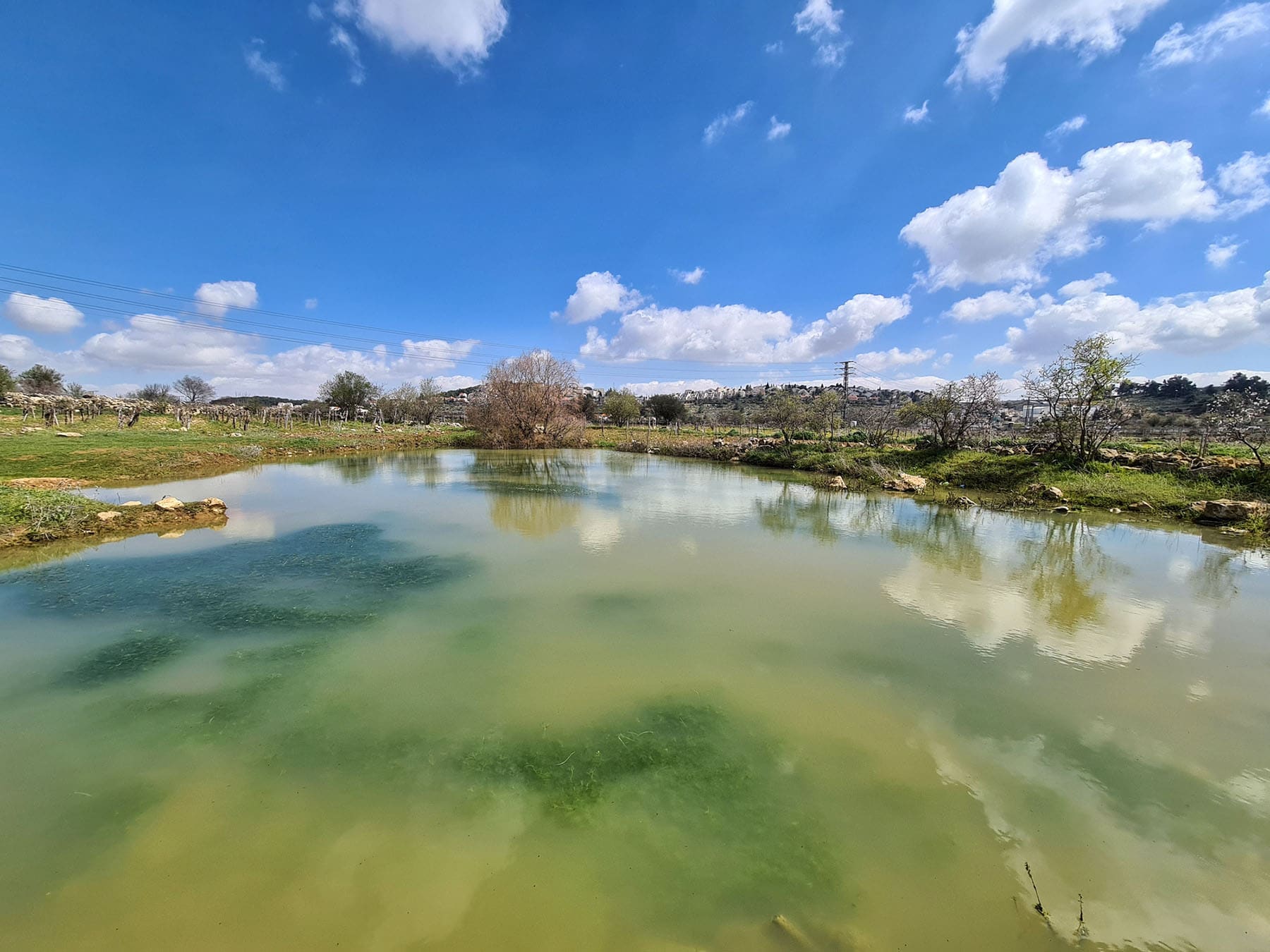 Vernal pool near Efrat, Gush Etzion, Israel (Photo by Yair Aronshtam/Getty Images)
Vernal pool near Efrat, Gush Etzion, Israel (Photo by Yair Aronshtam/Getty Images) As the heat of the summer begins to dissipate and the cooler weather begins to settle in, Israel will soon start to receive its seasonal and much needed rain. For a country so routinely inundated with dry weather, the much-anticipated rain will be of great help to farmers and provide a nice change of pace for those of us growing tired of this stretch of summer temperatures.
But beyond agriculture and marking a seasonal change, the fall-winter rains feed into and sustain important ecological habitats known as vernal pools, depressional wetlands that phase in and out with the change of the seasons in environments that exhibit a Mediterranean climate. When it rains, these areas fill with water, and they become lush beacons of biodiversity attracting a wide range of animals and insects, both endemic and migratory, and enabling numerous varieties of wildflowers to blossom and in an otherwise arduous environment.
But as climate change continues to put pressure on our environment, vernal pools are at risk of being a thing of the past as shifting weather patterns puts their cyclical reoccurrence in jeopardy. Already, California has lost more than 90% of its vernal pools due to the region’s characteristically relentless climate conditions. And as they disappear, so do the rare and important animal species that thrive in these habitats.
Throughout Israel’s predominately arid mainland, vernal pools provide extensive moist oasis-like ecosystems crucial for plant and animal life. However, much like California, these increasingly threatened ecosystems may soon disappear altogether from Israel’s local landscape and thus potentially deprive the country of much of its unique biodiversity.
Suffice it to say, conservation is key to preserve these vital habitats long-term. Following an extensive survey conducted in recent years thought Israel, the JNF (Jewish National Fund) has thankfully published their findings with regard to locating the country’s active vernal pools and what it will take to maintain them for the climatically worrisome years ahead.
Nature’s Pool Party
In 2018, the JNF’s Planning Division decided to conduct a large-scale general survey aimed at mapping the vernal pools located in the organization’s jurisdiction.
“As part of the survey, we visited 48 vernal pools and created an up-to-date database of them as well as their direct drainage basins,” says Dr. Eldad Elron, who co-authored the article with Dr. Yonatan Bar-Yosef.
“The duration of the water in the vernal pool is called a hydroperiod,” says Elron. “Basically, it is a habitat whose most unique feature is a seasonal body of water with two opposing periods: wet and dry.”
The wet period, as Dr. Elron explains, begins from the moment direct rain and surface runoff fill the open depression area whereas the dry period begins as the seasonal habitat starts to dehydrate via evaporation. By contrast, wet habitats like streams and lakes are permanent and therefore do not annually experience a period of absolute dryness.
According to experts, protecting the existence of vernal pools is necessary in order to preserve the unique variety of organisms that exist in Israel exclusively in this kind of habitat, which include a number of rare species and those that are considered endangered. Out of the seven species of amphibian that exist in the country, five of them are primarily found in and around Israel’s vernal pools: the European green toad (Bufotes viridis), the Levant water frog (Pelophylax bedriagae), the Middle East tree frog (Hyla savignyi), the Eastern spadefoot toad (Pelobates syriacus), and the southern banded newt (Ommatotrition/Triturus vittatus). The latter two are defined as critically endangered.
Beyond the habitat space and benefits of vernal pools, they also provide important services for us as well.
“Many of the pools are close to population centers and are accessible as nature sites allowing for leisure and recreational activities as well as sites for promoting research and education activities in schools. They can also help delay runoff that can lead to flooding,” says Dr. Elron.
Coping with the Dry Heat
As stated, vernal pools come and go according to seasonal changes, but the time between wet and dry periods can be very long and extreme, especially in Israel. Unsuitable conditions such as these coupled with persistent land development activity seriously affects the reproductive and survival strategies of the plants and animals that inhabit vernal pools.
In order to survive, species are forced to develop strategies for dealing with prolonged dry months or other manmade threats to avoiding dying out. One interesting strategy relates to the distribution of crabs to new vernal pools.
“Crab eggs can sometimes move from the pool in which they were laid to a new pond through the mud that sticks to the feet of passing animals. However, water insects are more successful than crabs in their distribution ability,” Dr. Elron notes. “Once the larvae have developed and before the winter pool dries, the adult stage of the insects can fly with the help of a pair of wings and skip to another body of water or land with more suitable growing conditions.”
Another reproductive coping strategy is exemplified by the Californian fairy shrimp (relative of crabs). Their eggs evolved a thick coating that protects the embryos against the heat and dehydration of the upcoming dry period. This protects them long enough until the next wet period arrives, at which point they are ready to hatch.
Pool of Maintenance
In the past, vernal pools used to be very common in Israel, but due to accelerated construction and the disappearance of open spaces, they are disappearing from the landscape. In fact, only less then 5% of the vernal pools that existed at the time Israel was established (1948) presently remain.
Luckily, surveys conducted over the past few years have yielded important findings regarding the challenge of conserving vernal pools. As stated, a decrease in the number and area of seasonal vernal pools causes a corresponding decrease in population counts of the species unique to them. Therefore, more efforts have been made in recent years to protect the last remaining vernal pools in Israel, and many of them have become protected nature reserves and subject to supervision by relevant nature and environment authorities.
During the surveys, the researchers saw a difference between pools located in different geographical areas and that external factors affect the existence and dimensions of them. In the first year of surveying, vernal pools in the Golan Heights were found to be larger and last longer than the those in the western Galilee, thus attracting a broader range of animals and organisms to fulfill the many ecological niches provided. This is in part due to the fact that the pools in the Golan Heights are older pools and receive greater amounts of rain.
The surveys also show that vernal pools in Israel are very sensitive to outdoor pollution.
“We’ve seen cattle herds around the pool adversely affect it,” says Dr. Elron. “Cattle defecate in the pool or its drainage basin, and as a result of the high organic load, a high concentration of nutrients are created adversely affecting the survival of organisms in the water.”
Beyond the main findings, the report includes general and individual recommendations for proper management and maintenance of each vernal pool. Among them, fencing the pools and preventing the entry of cattle herds into the immediately surrounding area are outlined. As well it is recommended to deepen the pools and plant suitable aquatic plants where needed. Management strategies also include changing any terrain route that interferes or disturbs the vernal pool ecosystem in any way.
“Fortunately, treatment began in the JNF-jurisdiction areas in the Western Galilee as early as the year following the initial 2018 survey,” Dr. Elron concludes.
ZAVIT – Science and the Environment News Agency





















 More news and opinions than at a Shabbat dinner, right in your inbox.
More news and opinions than at a Shabbat dinner, right in your inbox.